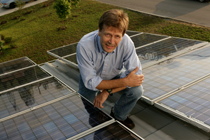Greening the Real World
Is your power bill 41 cents a day? It might be, if you live in Lenoir City, Tennessee
 Most days, Lenoir City, Tenn. resident Kim Charles doesn’t even notice the solar panels on her roof, the hum of her SEER 17 heat pump water heater, or the integrated design that places most of her home’s plumbing within one wall, saving precious energy. Most days, Lenoir City, Tenn. resident Kim Charles doesn’t even notice the solar panels on her roof, the hum of her SEER 17 heat pump water heater, or the integrated design that places most of her home’s plumbing within one wall, saving precious energy.
What she does notice is an electricity bill that averages about 41 cents per day and includes a 15 cent-per-kilowatt-hour credit from the Tennessee Valley Authority for sending electricity from her home back to the power grid.
Charles's home is among five in a local Habitat for Humanity community here fitted with the latest in energy-saving technologies as part of a research project by the Department of Energy’s Oak Ridge National Laboratory and the Tennessee Valley Authority.
 "Creating more energy-efficient buildings is not only part of the overall solution but is the number one most cost-effective opportunity to reduce the nation's energy consumption and affect climate change," said Jeff Christian, a buildings technology researcher at ORNL and coordinator of the Habitat for Humanity project. "Creating more energy-efficient buildings is not only part of the overall solution but is the number one most cost-effective opportunity to reduce the nation's energy consumption and affect climate change," said Jeff Christian, a buildings technology researcher at ORNL and coordinator of the Habitat for Humanity project.
In the United States, buildings command 40% of the nation's overall energy use, ranking above both industry, at 32%, and transportation, at 28%. Buildings also produce 43% of U.S. carbon emissions, using 38.8 quadrillion BTUs of energy each year, for heating, cooling, ventilation, lighting, water heating, refrigeration, and other energy demands.
Christian said residential energy consumption, unless aggressively addressed, is expected to grow 1% per year until 2025. On the commercial side, energy use is projected to increase an average annual rate of 2% between now and 2025, he said.
"Yes, we must replace oil with biofuels. Yes, we must pursue other supply-side solutions in an environmentally acceptable manner. But there is enormous potential to reduce energy demand in our homes and offices, and that is by far the cheapest solution if we really want to address this problem," Christian said.
ORNL researchers are supporting a DOE initiative to develop affordable, net-zero-energy housing by 2020 and zero-energy commercial buildings by 2025. The Habitat homes feature renewable energy sources to minimize demand for fossil fuels, such as heat pump systems that tap geothermal energy in the ground and solar panels to provide electricity and water heating capabilities. Energy efficient construction and technologies are incorporated, including roofs with “cool color” coatings to deflect heat, utility walls that consolidate most of the houses’ major plumbing (providing an energy savings of 15% in itself) and virtually airtight construction with advanced ventilation systems to keep the homes comfortable.
ORNL works with industry partners to develop construction materials and technologies needed for building greener homes. Researchers have tested solar-reflective roofing, insulation materials, structural insulated panels, solar technologies and foundation systems. The laboratory has developed software tools to assess moisture-resistant construction materials, provide energy efficiency ratings for buildings, design more efficient heat pumps and other equipment and guide development of standards for building insulation, materials and moisture design.
"I have noticed that when I tell people that these new houses have energy costs of approximately 50 cents a day, they tend to think about their own homes," Christian said. "People respond to the idea. They just need education and awareness."
Kim Charles is one of the educated. Since moving from her old house and $200-a-month utility bills, she and her young son, Brian, are taking time to do little things that conserve energy, such as keep the lights off when the sun is coming through the window. And Charles loves her home, not just for the energy savings technologies but also for its cathedral ceiling, sunlit windows, and friendly surrounding neighborhood.
"My home is brighter and more cheerful than my old house," she said. "This is just a great place to live."
For more information, please contact Department of Energy Public Affairs at 202-586-4940.
--
For additional information:
White House Fact Sheet: “Increasing Our Energy Security and Confronting Climate Change Through Investment in Renewable Technologies”
Department of Energy’s Building America Program
Department of Energy’s Oak Ridge National Laboratory is a multiprogram science and technology laboratory conducting basic and applied research and development to create scientific knowledge and technological solutions that strengthen the nation's leadership in key areas of science; increase the availability of clean, abundant energy; restore and protect the environment; and contribute to national security.
|